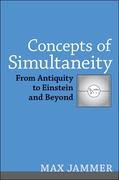38 Results for : simultaneity
-

Models of Simultaneity and Sequentiality in Human Cognition
Models of Simultaneity and Sequentiality in Human Cognition: ab 109.99 €- Shop: ebook.de
- Price: 109.99 EUR excl. shipping
-

Concepts of Simultaneity
Concepts of Simultaneity - From Antiquity to Einstein and Beyond: ab 45.49 €- Shop: ebook.de
- Price: 45.49 EUR excl. shipping
-
Mankind: The Story of All of Us
Prepare for an adrenaline-infused tale about the rise of civilization across the globe. From the producers of AMERICA THE STORY OF US, this 12-hour series on HISTORY spans the first flourishing of civilization in Mesopotamia all the way to the discovery of America. Groundbreaking production and CGI bring to life the greatest landmarks and milestones of human achievement by rebuilding lost worlds and creating large-scale reenactments of critical battles. Interactive maps dynamically illustrate the key factors that contributed to the birth and evolution of human endeavors. Focusing on the simultaneity of human experience-how ancient Egypt thrived while Stonehenge was being built, how China was at it's zenith while Europe was plunged into the Dark Ages-this landmark series captures all the action, struggle and heroism of our shared journey.- Shop: odax
- Price: 26.44 EUR excl. shipping
-
Hatfield, Ken : String Theory
String Theory - Ken Hatfield Some projects have longer gestation periods than others. The musical ideas on this recording had been percolating in my subconscious for quite awhile, but achieving the balance I desired between simultaneity and sequentiality proved to be elusive. The music on this CD is very personal to me. The forms of the compositions and the instrumentations employed for these recorded performances mirror the sounds that I heard in my 'mind's ear' at the time of each piece's creation. These imaginary sounds and the inspirations that gave rise to them guided every aspect of the compositional process, as well as the recording of my performances of each piece. Two prime objectives motivated the creation of this CD. First, I wanted to delve deeper into the nexus between improvisation and composition that I began to examine on my CD Explorations for Solo Guitar. And second, I felt compelled to undertake an emotional journey to reclaim aspects of my cultural heritage that, frankly, as a jazz musician I had spent a lot of energy trying to distance myself from, namely, my Appalachian roots. Two of the compositions ('Borges & I' and 'Snowhill Variations') are solo guitar pieces and were recorded with no overdubs. The other two pieces ('The Gospel According to Sam' and 'String Theory') were composed as duets and were recorded with that principle in mind. Consequently, though I obviously can't play the guitar and dobro or the guitar and mandolin at the same time, I did play each part as one half of it's respective duet. So the guitar parts for each piece were recorded with no overdubs, and then each of the other instruments was added as it was played, that is, as one integral half of each duet, with no overdubs within each part. The polyphonic nature of the writing does make this difficult, but it is the way the pieces were conceived, and the way they would be performed in a live concert setting. While modern recording technology makes it possible to separate the different voices within each instrument's part, assigning each voice it's own track, I chose not to use that procedure because I felt it would distort the sense of a dialogue between two equals that is central to my conception of the compositions. Each of the four multi-movement works that make up this CD was structured so that any single movement could stand on it's own, but when heard within the context of the entirety of it's surrounding movements, each movement illuminates it's neighbors. This concept is crucial for understanding the sources that inspired each of the four multi-movement works. Even though there are three or more movements within each work, each movement relates to a different aspect of the sources that inspired the work in which it is contained. For example, 'Borges & I' is constructed in the form of a suite with seven movements, each of which is named after a short story written by the great Argentine writer Jorge Luis Borges. Even the suite's overall title is named after one of Borges's short stories, and each movement of the suite was inspired by the short story after which it was named. While Borges's stories cover an enormous range of ideas and emotions, there are certain constants, which is in part why he is viewed as the father of a literary movement often referred to as 'magic realism.' One of the qualities I find most intriguing in Borges's work is his capacity for addressing the most profound aspects of the human condition in the most succinct terms. The form of the short story and the collections comprised of small numbers of them that were published during Borges's lifetime even resemble the form of a suite made up of individual movements. While my suite is not program music intended to underscore Borges's fictions (as he called them), it is an honest response to the masterful works of one of the 20th century's true visionaries. The inspiration for 'The Gospel According to Sam' was a large number of colorful sayings that I've heard throughout my life, expressed by an extraordinary man named Sam, who also happens to be my father. When I first moved to New York City and began working with a lot of different musicians, I found myself in some unfamiliar situations and responded from time to time with some of the witticisms of my father. For example, when a club owner started to deduct the cost of a glass of water from the band's pay, insisting it was on a musician's bar tab, I responded by saying that the club owner was 'tighter than a fish's ass, and that's watertight.' My fellow musicians loved these expressions so much that they often asked where on earth I came up with the stuff. When I told them, several suggested that I put together a book of my Dad's more outlandish expressions and title it 'The Gospel According to Sam.' My Dad loves the dobro, so I wrote 'The Gospel According to Sam' for him. 'Snowhill Variations' was inspired by a story told during a lecture attended by Adrian Leverkühn, the main character in Thomas Mann's novel Dr. Faustus. As a young man Adrian attended lectures about music, and during one such lecture the speaker speculates that music is such a natural art that, even without the benefit of instruction or guidance and by merely observing the natural implications of sound, a musically talented novice could reinvent music, with the results being much the same as the music we know today (or at least at the time of the novel, the early 20th century). To illustrate his point the lecturer tells the story of Johann Beissel, who formed a religious order in Pennsylvania. Beissel received what he believed to be divinely inspired poems that were messages for the faithful. Upon hearing choral music Beissel decided that his poems would be more effectively communicated with music. Knowing nothing about music did not intimidate Herr Beissel, he simply invented his own method for creating credible vocal music using a system of what he referred to as 'master and slave' tones, not unlike the system of chord tones and alternating passing tones that explain many of our chord-scale relationships today. While this story was only a small but interesting part of Mann's novel, I was intrigued by it. However, I assumed that, like the rest of the novel, it was fiction. To my surprise I found out that Beissel really existed, that he did invent a system for creating choral music, and that he founded religious sects at Ephrata and at Snowhill, Pennsylvania. I began to imagine what Beissel's music might have sounded like, and a theme took shape in my mind. When I began to play around with it on paper, I was surprised to hear how malleable it was. So I wrote twelve variations on it. The title piece for the CD, 'String Theory,' didn't have a single source of inspiration. Rather, it emerged from a serendipitous confluence of encounters with art and science, and my own observations on the interactions between these two seemingly disparate disciplines. For example, when I first saw the Henry Moore drawing that graces the cover of this CD, and the way in which it's audience quizzically awaits the unveiling of the monolithic structure covered in something bound by string, it struck me as a visual metaphor for the way physicists are awaiting the next step in the process of proving or disproving the validity of string theory. I was also fascinated by the way that some physicists began naming subatomic particles and/or the forces governing their behavior with names like 'Grace' and 'Love,' and how the deeper they get into it, the stranger it becomes-with a projected eleven dimensions to reality. It seems that the weirder their discoveries, the more physicists use names of familiar qualities to describe the tendencies of the phenomena they either predict or discover. Finally, there is the conspicuous fact that every instrument I play on this recording has strings attached. I always look for a unifying principle to hold things together, and 'String Theory' seemed the obv- Shop: odax
- Price: 30.91 EUR excl. shipping
-
Refusal of Time
A work in progress in the truest sense,The Refusal of Time continues and deepens the polymorphic, dreamlike, political and humanist body of work developed by Kentridge from his very earliest days as an artist. An installation with performance elements, The Refusal of Time was conceived by Kentridge and science historian Peter Galison for Documenta (13) - 2012 in Kassel, Germany - and realized in collaboration with video filmmaker Catherine Meyburgh and composer Philip Miller. Time in it's various manifestations--narrative, fragmented, slowed down and speeded up, distortions of space-time, simultaneity--is explored through various media, including dance, film, music and spoken word.- Shop: odax
- Price: 21.88 EUR excl. shipping
-
-
Falstaff
The stout Sir John Falstaff has financial problems. To refill his empty pockets he strives for amorous affairs with Alice and Meg, the wives of the rich citizens Ford and Page. The two ladies might even have consented, had they not received identical love letters. So they decide to play a trick on him. At the same time Alice exposes her husband’s chronic jealousy. In the end, Nannetta, the Fords’ daughter, is allowed to marry for love against her father’s plans. Finally, a nightly masquerade in Windsor park brings out the moral of the story: „Tutto nel mondo è burla – All the world’s a burlesque“. Towards the end of his operatic work, Giuseppe Verdi succeeds in a brilliant comedy of characters with philosophical wisdom and sparkling musical wit. The libretto of Arrigo Boito is based upon William Shakespeare’s comedy „The Merry Wives of Windsor“ and scenes from „Henry IV“. Bernd Weikl’s witty production shows the simultaneity of tragedy and comedy. The opera’s motto „All the world’s a burlesque“ is also reflected in the stage design of Thomas Doerfler and in the costumes of Julia Holewik. Both set and clothes are inspired by Shakespeare’s theatre, the Italian tradition of „Commedia dell’ arte“ and the world of circus.- Shop: odax
- Price: 22.64 EUR excl. shipping
-





